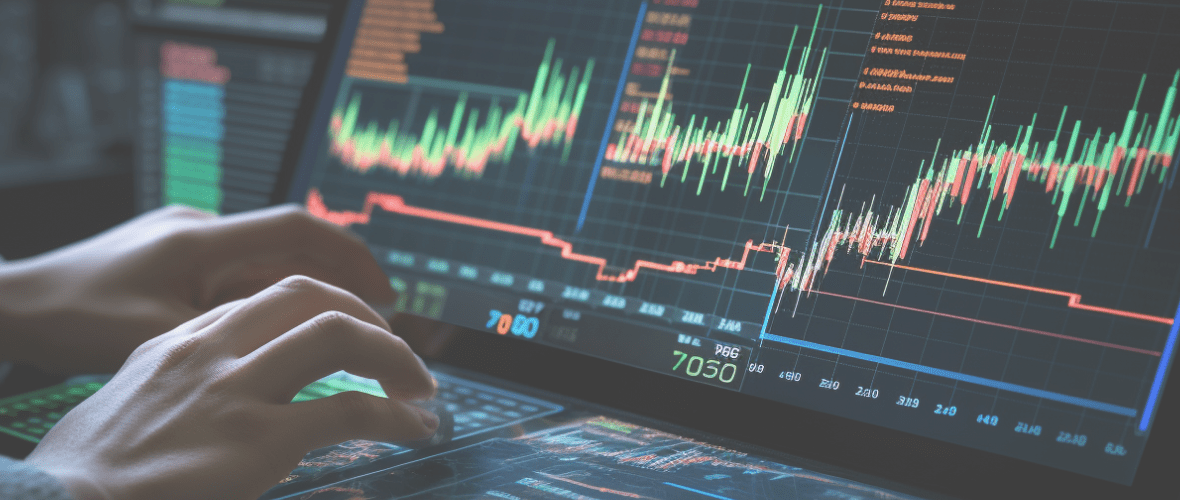Have you ever wondered how crypto traders navigate the highly volatile and unpredictable world of cryptocurrencies? The key often lies in their adept use of technical indicators, tools that provide critical insights into market trends and help inform trading decisions.
This article delves into the most popular technical indicators used in the crypto market. We’ll explore how each indicator works and why they’re indispensable in a trader’s toolkit. Alongside this, we’ll also show how Kriptomat’s advanced tools and features can help you enhance your trading strategies. Whether you’re a seasoned trader or just starting, grasping these concepts can elevate your trading strategy, providing clarity amidst the chaos of the crypto market.
Key technical indicators in crypto trading
Technical indicators are mathematical calculations based on the price, volume, or open interest of a cryptocurrency. They are used to forecast future price movements, providing traders with insights that go beyond raw price data. These indicators help in identifying entry and exit points, gauging market sentiment, and making informed decisions based on historical data patterns.
Technical indicators in crypto trading can be classified into several categories, such as trend indicators, momentum indicators, volume indicators and volatility indicators. Let’s take a closer look at each category.
Trend indicators
Trend Indicators help traders identify the direction and strength of a market trend. They smooth out price fluctuations to show a clearer market direction.
Simple and Exponential Moving Averages (SMA and EMA)
Moving Averages (MAs) are key trend indicators in crypto trading, smoothing price data to show clear trend directions. The Simple Moving Average (SMA) calculates the average price over set periods, equally weighing all prices.
In contrast, the Exponential Moving Average (EMA) prioritises recent prices, reacting faster to new market changes. MAs help identify support and resistance levels and indicate trend directions, with rising MAs suggesting uptrends and falling MAs indicating downtrends. Dive deeper into Moving averages with our article “How to Use Moving Averages for Crypto Trading”.
Moving Average Convergence Divergence (MACD)
The MACD is a comprehensive trend indicator in crypto trading, displaying the relationship between two moving averages. It includes the MACD line (the difference between two EMAs), the signal line (EMA of the MACD line), and the histogram (the gap between the MACD and signal lines).
Traders use MACD crossovers to identify buy or sell signals: a MACD line crossing above the signal line indicates a bullish trend and potential buy, while a cross below suggests a bearish trend and a sell signal. The MACD also gauges trend momentum and strength, with a growing gap between the MACD and signal lines signalling stronger trends.
Momentum indicators
Momentum indicators measure the speed of price movements. They help traders identify overbought or oversold conditions, often signalling potential reversals.
Relative Strength Index (RSI)
The RSI is a momentum indicator that measures the speed and change of price movements, typically over a 14-day period. It oscillates between 0 and 100.
An RSI above 70 indicates that a coin is overbought, suggesting that it might be due for a price correction or reversal. Conversely, an RSI below 30 suggests that a coin is oversold, potentially signalling an upcoming price increase.
RSI is particularly useful in the volatile crypto market as it can help traders spot potential reversal points by identifying extreme market conditions.
Stochastic Oscillator
The Stochastic Oscillator, scaling from 0 to 100 like the RSI, measures price momentum over a specific period. Key levels are 20 and 80, with readings above 80 indicating an overbought market and below 20 suggesting oversold conditions.
In crypto trading, a move above 80 followed by a decline signals a potential sell, while a dip below 20 with a subsequent rise indicates a buying opportunity. This tool is especially effective in identifying reversals in volatile or range-bound crypto markets.
Volume indicators
These indicators track the trading volume of a cryptocurrency. They can indicate the strength of a price movement, with high volume often confirming a trend.
On-Balance Volume (OBV)
The On-Balance Volume (OBV) is an indicator in crypto trading that uses volume flow to forecast price changes, aggregating buy and sell volumes for a snapshot of market sentiment.
A rising OBV indicates increased buying and potential uptrends, while a falling OBV suggests rising selling pressure and possible downtrends. Useful in confirming or predicting trend reversals, a discrepancy between a cryptocurrency’s price trend and OBV movement can signal a lack of support for the current trend.
Volume Rate of Change (VROC)
The Volume Rate of Change (VROC) indicator assesses how rapidly trading volume changes, pinpointing quick increases or decreases. It’s key for spotting breakouts, as a sharp volume rise with little price change may signal an upcoming major price move. VROC also aids in confirming trend continuations; a rising price with a growing VROC suggests bullishness, while a falling price with increasing VROC indicates bearishness.
Volatility indicators
These indicators provide insights into the market’s volatility. They help traders understand the level of price fluctuations and market uncertainty, which is particularly useful in the crypto market.
Bollinger Bands
Bollinger Bands feature three lines: a central moving average and upper/lower bands indicating market volatility. Narrow bands signal low volatility; wider bands suggest high volatility. Traders use them to spot overbought (price near upper band) or oversold (price near lower band) conditions and potential sell-offs. They also identify “squeezes” when bands tighten, hinting at an upcoming significant price move.
Average True Range (ATR)
The Average True Range (ATR) measures market volatility by analysing an asset’s range over a period, typically providing a 14-day moving average. In crypto trading, the ATR is valuable for setting stop-loss orders: a higher ATR implies more volatility, necessitating wider stop-losses, while a lower ATR suggests less volatility and tighter stop-losses. While ATR doesn’t indicate price direction, it’s useful alongside other indicators for determining entry and exit points.
How to effectively combine indicators?
Relying on a single indicator for trading decisions can be limiting. A more effective approach is to use a combination of indicators to enhance the accuracy of predictions and help manage risks more effectively.
Using multiple indicators offers a comprehensive market view, balancing conflicting signals for more informed decisions. This approach helps reduce false signals, as different indicators validate each other. Combining indicators also provides diverse market perspectives, covering trend direction, momentum, volatility, and volume.
Let’s look at a few examples of useful combinations of indicators:
- Trend and momentum combination: Pairing a trend indicator like the MACD with a momentum indicator like the RSI can be powerful. For example, if MACD shows a bullish crossover while RSI moves above 30 (rising from oversold conditions), it could reinforce a strong buy signal.
- Volatility and volume analysis: Using Bollinger Bands with the OBV can help traders understand market dynamics. A price breakout from Bollinger Bands accompanied by a rising OBV can indicate strong buyer interest, confirming the breakout’s strength.
- Trend and volume correlation: Combining trend indicators like EMAs with volume indicators can help confirm the strength of a trend. For instance, a rising EMA along with increasing volume can suggest a strong and healthy uptrend.
By strategically combining various indicators, crypto traders can make better decisions to maximise gains and minimise risks.
Best practices for applying technical indicators
Applying technical indicators effectively in the volatile world of cryptocurrency trading requires more than just understanding their functionalities. It demands a disciplined approach and a keen awareness of the market context. Here are some best practices to keep in mind:
- Understand market context: Always consider the broader market conditions when interpreting indicators, as their signals can vary in bull versus bear markets and are influenced by economic, regulatory, and technological factors.
- Use indicators judiciously: Avoid over-relying on indicators. While they are useful tools, they are not infallible and should not be the sole basis for trading decisions. Combine indicator analysis with other forms of research, such as fundamental analysis and market sentiment. Delve into the essentials of coin evaluation with our comprehensive tutorial on fundamental analysis “What Are the Key Elements of Fundamental Analysis in Crypto Trading?”
- Backtest: Use historical data to backtest new indicators or strategies before live trading, assessing their past performance for future effectiveness.
- Adapt when necessary: Regularly update your strategies in response to the ever-changing crypto market dynamics.
- Manage risk: Complement strategies with solid risk management, including stop-loss orders, controlled position sizing, and portfolio diversification to minimise potential losses.
Adopting these best practices can significantly enhance the effectiveness of technical indicators in crypto trading. They help in creating a more disciplined, informed, and adaptable approach to navigating the complexities of the cryptocurrency markets.
Optimise your trading with Kriptomat’s tools
Incorporating Kriptomat’s advanced tools can significantly boost your application of popular technical indicators in crypto trading. Here’s how:
- Kriptomat provides access to a broad spectrum of cryptocurrencies, allowing you to apply technical indicators across various market conditions and assets for a comprehensive analysis.
- The platform’s sophisticated charting tools let you seamlessly overlay popular indicators onto price charts. This enhances your ability to spot trends, identify potential entry and exit points, and make informed trading decisions. Learn how to use Kriptomat’s Advanced charting tools in our guide “How to Use Kriptomat’s Advanced Price Charts?”
- Kriptomat’s real-time market data, Watchlist and Price alerts let you stay updated with the latest market movements and receive alerts on desired price changes. This is crucial for timely application of technical indicators, ensuring you’re always a step ahead.
- With automated trading options like Recurring Buy and Automated Buy and Sell, Kriptomat enables you to implement strategies automatically, helping you capitalise on market opportunities even when you’re not actively monitoring the market. Explore these features with our guides “What is Automated Buy & Sell? How Do I Use It?” and “What is Recurring Buy and how does it work?”.
- Kriptomat’s Portfolio analytics tracks investment performance and offers insights for strategy refinement. Learn more about effective portfolio management in our tutorial, “What is Portfolio Analytics and how to use it?”
- Finally, Kriptomat offers in-depth tutorials on crypto trading tools, along with responsive customer support to assist with any queries.
Zooming out
In this exploration of technical indicators for cryptocurrency trading, we’ve delved into the nuances of trend, momentum, volume, and volatility indicators. Each category plays a crucial role in providing traders with valuable insights into market behaviours and potential future movements.
As you continue your trading journey, we encourage you to dive deeper into each of these indicators and refine your strategies. Kriptomat offers a wealth of educational content to aid in this endeavour. By signing up for a Kriptomat account, you gain access to tools and resources that can enhance your trading skills and keep you updated with the latest market trends and analysis techniques. Embrace continuous learning and let Kriptomat be your guide in the dynamic world of cryptocurrency trading.
NOTE
This text is informative in nature and should not be considered an investment recommendation. It does not express the personal opinion of the author or service. Any investment or trading is risky, and past returns are not a guarantee of future returns. Risk only assets that you are willing to lose.



 IOS
IOS Android
Android